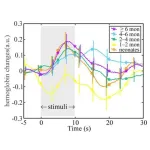Tracing how the infant brain responds to touch with near-infrared spectroscopy
Oxygenated hemoglobin levels can help us track physiological development
2023-12-09
(Press-News.org)
Tokyo, Japan – Researchers from Tokyo Metropolitan University have measured how oxygenated hemoglobin levels in the blood change in infants’ brains in response to touch. Using spectroscopy methods with external sensors placed on the scalp of sleeping infants, they found that the time at which levels peak doesn’t change with infant age, but the amount by which it varies over time does. Insights like this shed light on how the physiology of infants develop.
The first phase of a newborn’s life is a dazzling array of rapid developmental changes. And neuroscience is giving us unprecedented insight into these processes, powered by state-of-the-art measurement techniques. Two key tools on this journey are functional magnetic resonance imaging (fMRI) and near-infrared spectroscopy (NIRS) of the brain. With NIRS, an array of external sensors placed on a infant’s head lets scientists track how the flow of different compounds in the brain change over time. There is a particular focus on hemoglobin, the key oxygen-carrying component of our blood. As the brain responds to input from the outside world like light, heat, and touch, oxygen rushes to the brain; NIRS lets us pick out levels of hemoglobin, even telling apart whether it is carrying oxygen or has already delivered its cargo.
Now, a team led by Assistant Professor Yutaka Fuchino from Tokyo Metropolitan University have applied NIRS to study how infant brains respond to touch. Looking at a range of infants aged zero to one, the team placed sensors on infants’ scalps as they slept, and tracked how oxygenated hemoglobin levels change over time as their limbs were given a very gentle shake. Interestingly, infants at different ages over their first year showed a very similar response time, with a small peak in hemoglobin appearing a few minutes after the stimulus began. The fact that infants in their first month responded in basically the same way to those over six months suggests that the factors determining the speed of the response are complete at birth.
However, they also noticed that the range over which the signal varied, or the amplitude, was markedly different between infants in different age groups. The change was also not linear, in that it dipped for infants 1 to 2 months old then increased again as the age increased. This curious behavior could be attributed to certain aspects of a newborn infant’s first few months. For one, when they are born, there is a rapid rise in oxygen levels due to being able to breathe normally for the first time. This inhibits the production of erythropoietin, a small protein responsible for stimulating red blood cell production; this leads to a temporary anemia over the first few months. Levels gradually recover as erythropoietin production ramps up again to compensate. Other factors include developments in nerves, veins, and levels of blood flow.
Importantly, the team’s work highlights how NIRS statistics of hemoglobin levels in the brain can reflect developmental changes. Future studies promise to compare other physiological responses to changes in blood flow dynamics, yielding further insights into how the brain and its interactions with the body develop.
This work was supported by KAKENHI Grants-in-Aid for Young Scientists (B) (Grant Number 16K21266), Scientific Research on Innovative Areas (Grant Number 24119001), and Scientific Research (C) (Grant Number 19K02589).
END
[Attachments] See images for this press release:


ELSE PRESS RELEASES FROM THIS DATE:
2023-12-09
Which charities will be most effective in ensuring your donation is put to good use? For the first time in the Netherlands, researchers applied scientific methods to pinpoint which charities achieve the most with the donations they receive. The University of Amsterdam and Stichting Doneer Effectief (Donate Effectively Foundation) unveiled the list on Friday, 8 December, during a sold out evening in Rotterdam. ‘We are talking about the Champions League of good causes,’ says professor of Philanthropy & Sustainable Investment Paul Smeets of the University of Amsterdam. The ranking ...
2023-12-08
The shimmering green, red and purple curtains of the northern and southern lights — the auroras — may be the best-known phenomena lighting up the nighttime sky, but the most mysterious are the mauve and white streaks called Steve and their frequent companion, a glowing green "picket fence."
First recognized in 2018 as distinct from the common auroras, Steve — a tongue-in-cheek reference to the benign name given a scary hedge in a 2006 children's movie — and its associated picket fence were nevertheless thought to be caused by the same physical processes. But scientists were left scratching their heads about how these glowing emissions ...
2023-12-08
The High Energy Physics Advisory Panel (HEPAP) to the High Energy Physics program of the Office of Science of the U.S. Department of Energy and the National Science Foundation’s Division of Physics has released a new Particle Physics Project Prioritization Panel (P5) report, which outlines particle physicists’ recommendations for research priorities in a field whose projects — such as building new accelerator facilities — can take years or decades, contributions from thousands of scientists, and billions of dollars.
The 2023 P5 report represents the major activity in the field of particle physics that ...
2023-12-08
CHAPEL HILL, NC — Eating food and absorbing its nutrients is an everyday occurrence, but this normal activity can look different for someone who suffers from inflammatory bowel disease. IBD, which includes Crohn’s disease and ulcerative colitis, can cause chronic inflammation of the digestive tract – which for many reasons can lead to malnutrition. This malnourished state is associated with an increased risk of morbidity and mortality, and new findings show that many patients in IBD clinic screen positive for malnutrition, leading to the critical need for same-day ...
2023-12-08
The following news release on the 2023 Particle Physics Project Prioritization Panel (P5) report is based on one issued today by the American Physical Society (APS) with added content specific to the U.S. Department of Energy’s (DOE) Brookhaven National Laboratory. For more information about Brookhaven Lab’s research in particle physics, contact: Karen McNulty Walsh, kmcnulty@bnl.gov, (631) 344-8350. For APS media inquiries, contact Anna Torres, torres@aps.org, (301) 209-3605.
WASHINGTON, ...
2023-12-08
STARKVILLE, Miss.––A Mississippi State University anthropologist’s bioarchaeological analysis and bone samples from ancient Roman burial sites were crucial in the development of new research regarding Roman and Balkan migration featured this week in Cell, a prestigious peer-reviewed journal.
Anna Osterholtz, an associate professor in the Department of Anthropology and Middle Eastern Cultures, provided her research on the “lived experiences” of the Romans in Croatia. She currently works closely with museum ...
2023-12-08
But when those batteries – heart muscle cells called cardiomyocytes − short circuit and die, the damage can be devastating. The damage to the heart muscle is usually permanent, leaving the heart unable to pump the way it should.
That’s the subject of a new study by a team that includes two USF Health doctors who reported their findings in Circulation, the flagship journal of the American Heart Association.
“An injury like a heart attack creates a massive loss of cardiomyocytes, and you can’t renew them,’’ said Da-Zhi Wang, PhD, director of the Center for Regenerative Medicine in the USF Health Heart Institute and Morsani College ...
2023-12-08
In 2014, the Nobel Prize in Chemistry celebrated the breakthroughs in super-resolution microscopy, a technology that allows us to capture highly detailed images of small parts of cells using fluorescent microscopy. Despite its success, the resolution of super-resolution microscopy still can’t show tiny distances between organelles in cells. This gap is where Artificial Intelligence (AI) and Biomedical Computer Vision intersect, as researchers from SFU Computing Science and UBC School of Biomedical Engineering and Life Sciences Institute reveal how AI enhances super-resolution microscopy ...
2023-12-08
Contributions from Argonne will drive innovation in particle physics and shed light on outstanding mysteries in the field.
Yesterday marked the release of a highly anticipated report from the Particle Physics Project Prioritization Panel (P5), unveiling an exciting new roadmap for unlocking the secrets of the cosmos through particle physics.
The report was released by the High Energy Physics Advisory Panel to the High Energy Physics program of the Office of Science of the U.S. Department of Energy (DOE) and ...
2023-12-08
A $3.8 million grant from the National Institute of Environmental Health Sciences, a division of the National Institutes of Health, will fund planning for the Southwest Center on Resilience for Climate Change and Health, or SCORCH, at the University of Arizona fund planning for the Southwest Center on Resilience for Climate Change and Health, or SCORCH, at the University of Arizona Mel and Enid Zuckerman College of Public Health. The center will focus on research and programs to help communities in Arizona and other hot, dry geographic regions adapt to climate-driven health ...
LAST 30 PRESS RELEASES:
[Press-News.org] Tracing how the infant brain responds to touch with near-infrared spectroscopy
Oxygenated hemoglobin levels can help us track physiological development




